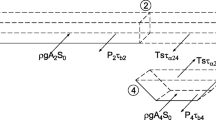Abstract
In river flow, two coefficients can be used to minimize the error in hydraulic calculations introduced by the use of mean velocity, the energy coefficient (α) and the momentum coefficient (β). Both coefficients vary in a range close to and above one; however, it is usually considered to be constant and equal to unit. In this paper, we estimate the two coefficients in three rivers at Northern Greece based on measurements of the water depth, the wetted area and the velocity flow. These measurements were taken for a period of about 2 years, and the results show that the two coefficients are always above unit and vary in time. Also, the coefficients are affected by the existence of the submerged vegetation and by the existence of subsections. The variation of coefficients could be an important parameter in a river flow simulation where the flow conditions differ from the uniform flow.













Similar content being viewed by others
References
Agu CE et al (2017) Algorithm with improved accuracy for real-time measurement of flow rate in open channel systems. Flow Meas Instrum 57:20–27
Akan AO (2011) Open channel hydraulics. Butterworth-Heinemann, Oxford
Brunner GW (2016) HEC-RAS river analysis system—hydraulic reference manual, Version 5.0., (February), p 547
Chanson H (2006) Minimum specific energy and critical flow conditions in open channels. J Irrig Drain Eng 132(5):498–502
Chao-Lin C, Murray DW (1992) Variation of velocity distribution along nonuniform open-channel flow. J Hydraul Eng 118(7):989–1001
Chaudhry MH (2007) Open-channel flow. Springer, Berlin
Cheng RT, Gartner JW (2003) Complete velocity distribution in river cross-sections measured by acoustic instruments. In: Proceedings of the IEEE/OES seventh working conference on current measurement technology, 2003. IEEE, pp 21–26
Chiu C-L, Hsu S-M (2006) Probabilistic approach to modeling of velocity distributions in fluid flows. J Hydrol 316(1):28–42
Chow VT (1959) Open channel flow. McGraw-HILL, London
Dias F, Dyachenko AI, Zakharov VE (2008) Theory of weakly damped free-surface flows: a new formulation based on potential flow solutions. Phys Lett A 372(8):1297–1302
Endreny T, Lautz L, Siegel DI (2011) Hyporheic flow path response to hydraulic jumps at river steps: flume and hydrodynamic models. Water Resour Res 47(2):1–13
Fenton J (2005) Open channel hydraulics. Engineering Hydraulics Hydrol 54(6)
Fenton JD (2005b) On the energy and momentum principles in hydraulics. In: XXXI IAHR congress. Seoul, Korea
French RH (1985) Open-channel hydraulics. Mc Graw-Hill, London
Hamidifar H, Omid MH, Keshavarzi A (2016) Kinetic energy and momentum correction coefficients in straight compound channels with vegetated floodplain. J Hydrol 537:10–17
Hasníková E, Pavlásek J, Vach M (2015) Spatial interpolation of point velocities in stream cross-section. J Hydrol Hydromech 63(1):21–28
Herschy RW (2009) Streamflow measurement, 3rd edn. Taylor & Francis, New York
Keshavarzi A, Hamidifar H (2018) Kinetic energy and momentum correction coefficients in compound open channels. Nat Hazards 92(3):1859–1869
Kolupaila S (1956) Methods of determination of the kinetic energy factor. Port Eng Calcutta India 5(1):12–18
Kotlyakov AV et al (2007) Field studies of river flow dynamics in the lower pool of a hydrosystem. Water Resour 34(4):401–407
Kubrak E, Kubrak J, Kiczko A (2015) Experimental investigation of kinetic energy and momentum coefficients in regular channels with stiff and flexible elements simulating submerged vegetation. Acta Geophys 63(5):1405–1422
Mohanty PK, Khatua KK (2014) Estimation of discharge and its distribution in compound channels. J Hydrodyn 26(1):144–154
Montes S (1998) Hydraulics of open channel flow. ASCE Press, United States
Parsaie A (2016) Analyzing the distribution of momentum and energy coefficients in compound open channel. Model Earth Syst Environ 2(1):1–5
Riahi-Madvar H et al (2011) Uncertainty analysis of quasi-two-dimensional flow simulation in compound channels with overbank flows. J Hydrol Hydromech 59(3):171–183
Szymkiewicz R (2010) Numerical modeling in open channel hydraulics. Springer, Berlin
Tazioli A (2011) Experimental methods for river discharge measurements: comparison among tracers and current meter. Hydrol Sci J 56(7):1314–1324
Temple DM (1986) Velocity distribution coefficients for grass-lined channels. J Hydraul Eng 112(3):193–205
Wali UG (2013) Kinetic energy and momentum correction coefficients for a small irrigation channel. Int J Emerg Technol Adv Eng 3:315–322
Watts J, Simons DB, Richardson EV (1967) Variation of α and β values in a lined open channel. J Hydraul Div 93(6):217–234
Xia R, Yen BC (1994) Significance of averaging coefficients in open-channel flow equations. J Hydraul Eng 120(2):169–190
Zeman E, Zizka R (1989) Some aspects of hydrodynamic models used in mountainous areas. IAHS-AISH Publ 190:403–417
Acknowledgements
The data used in this paper were collected in the framework of the elaboration of the national water resources monitoring network, supervised by the Special Secretariat for Water—Hellenic Ministry for the Environment and Climate Change. This Project is elaborated in the framework of the operational program Environment and Sustainable Development which is co-funded by the National Strategic Reference Framework (NSRF) and the Public Investment Program (PIP).
Author information
Authors and Affiliations
Corresponding author
Additional information
Publisher's Note
Springer Nature remains neutral with regard to jurisdictional claims in published maps and institutional affiliations.
Rights and permissions
About this article
Cite this article
Pantelakis, D., Hatzigiannakis, E., Doulgeris, C. et al. Calculation of the energy and the momentum coefficients based on measurements in Greek rivers. Model. Earth Syst. Environ. 6, 1163–1175 (2020). https://doi.org/10.1007/s40808-020-00748-3
Received:
Accepted:
Published:
Issue Date:
DOI: https://doi.org/10.1007/s40808-020-00748-3




